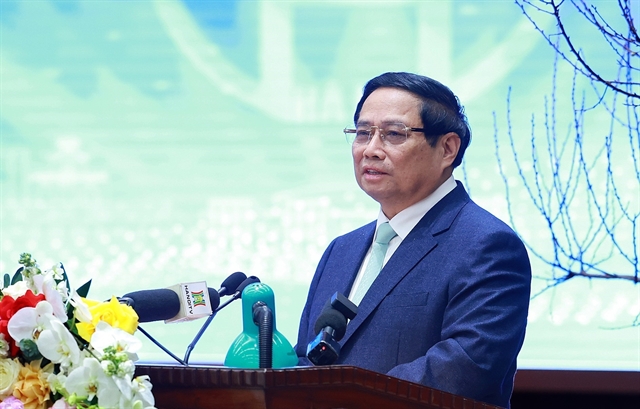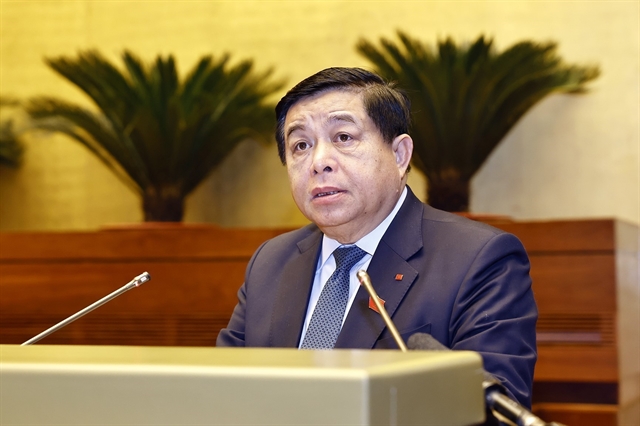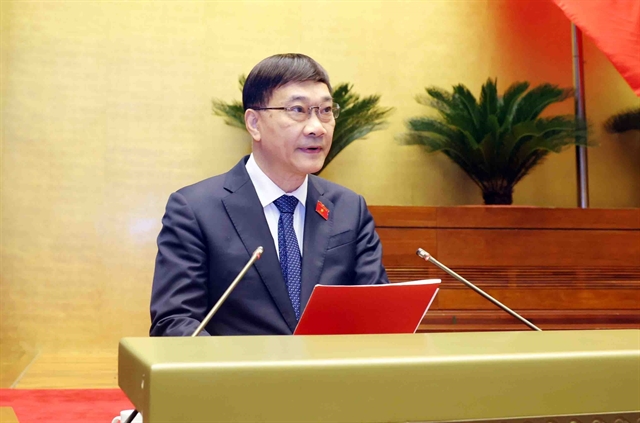 Politics & Law
Politics & Law

 |
| Minister of Planning and Investment Nguyễn Chí Dũng at the opening session of the ninth extraordinary National Assembly meeting on Wednesday morning in Hà Nội.—VNA/VNS Photo Doãn Tấn |
HÀ NỘI — The national GDP growth target for 2025 is set to exceed 8 per cent, laying a solid foundation to achieve double-digit growth in the future.
The Consumer Price Index (CPI) is expected to rise by around 4.5–5 per cent. In certain cases, a fiscal deficit of approximately 4–4.5 per cent of GDP may be considered to mobilise resources for development investment. Public debt and foreign debt may approach or exceed the warning threshold of around 5 per cent of GDP.
Minister of Planning and Investment Nguyễn Chí Dũng, gave the figures when presenting the proposal for the 2025 socio-economic development plan during the opening session of the ninth extraordinary National Assembly meeting on Wednesday morning in Hà Nội.
While aiming for rapid growth, the priority is to ensure sustainability, maintaining macroeconomic stability, controlling inflation and ensuring the balance of key factors, Dũng said.
This includes the harmonious development of the economy, society, environmental protection, alongside safeguarding national security and defence.
Under the scenario of reaching 8 per cent growth in 2025, industrial and construction growth is expected to exceed 9.5 per cent, with processing and manufacturing industries growing by at least 9.7 per cent.
The services sector is projected to grow by at least 8.1 per cent, while agriculture, forestry and fisheries are expected to increase by 3.9 per cent or more.
The sectors are forecast to grow 0.7–1.3 per cent higher than in 2024.
The industrial and construction sectors, particularly the processing and manufacturing industries, will continue to drive overall growth.
The GDP scale for 2025 is projected to exceed US$500 billion, with GDP per capita estimated to be above $5,000.
Growth drivers include total social investment of around $174 billion or more, accounting for about 33.5 per cent of GDP (an increase of over $3 billion).
Of this, public investment will account for approximately $36 billion, a rise of approximately $3.39 billion compared to the 2025 target.
Private investment will be about $96 billion, foreign direct investment (FDI) will reach around $28 billion and other investments will contribute approximately $14 billion.
Retail sales of goods and consumer service revenue (at current prices) are expected to grow by at least 12 per cent.
Trade turnover (exports and imports) is forecast to increase by at least 12 per cent, with a trade surplus of approximately $30 billion.
Dũng also added that achieving the 8 per cent growth target requires new thinking, innovative methods and breakthroughs in institutional frameworks and solutions.
He stressed the importance of decentralisation and empowerment to ensure efficiency.
It is crucial to streamline administrative processes without negatively impacting the public or the operations of businesses in the short term.
“The role of growth-leading regions, economic corridors and growth poles must be maximised”, he said.
In particular, the GRDP growth of localities should reach at least eight to 10 per cent, with Hà Nội, HCM City and other key cities striving for higher growth rates than the national average.
There should be appropriate incentives for high-growth areas, with central government adjustments to ensure balanced development.
Traditional growth drivers such as investment, consumption and exports should be revitalised, while accelerating the development of science and technology, innovation, digital transformation and a high-quality workforce.
These factors will increasingly drive national growth.
National Assembly comments
 |
| Vũ Hồng Thanh, Chairman of the National Assembly's Economic Committee at the opening session of the ninth extraordinary National Assembly meeting on Wednesday morning in Hà Nội.—VNA/VNS Photo Phạm Kiên |
Upon reviewing the Government’s proposal, Vũ Hồng Thanh, Chairman of the National Assembly's Economic Committee, said that the proposed adjustment to the 2025 economic growth target demonstrates the Government’s commitment to achieving the economic and social development goals for the 2021–25 period.
It contributes to laying a solid foundation for sustained double-digit growth and propels the country towards a prosperous development era.
However, Thanh said that early 2025 has seen slow progress in production and business activities.
The Industrial Production Index (IIP) for January 2025 increased by only 0.6 per cent year-on-year, and the Purchasing Managers' Index (PMI) has been below 50 points for two consecutive months, indicating a shrinking business environment in the country's production sector.
“Therefore, a detailled analysis is needed to ensure the feasibility of the proposal, particularly in safeguarding national financial security and public debt safety,” he added.
Regarding the CPI target, the committee agreed that adjusting the CPI target is necessary to provide space for managing fiscal and monetary policies, supporting economic growth.
However, with core inflation in January 2025 at 3.07 per cent, higher than the average for 2023 (2.71 per cent), inflationary pressure remains significant.
Thus, effective inflation control measures should be implemented alongside growth objectives to maintain macroeconomic stability.
Regarding the proposal to adjust the public debt and fiscal deficit targets, the committee said that this is essential to mobilise resources for development investment.
“However, clear plans for using the increased deficit and public debt must be outlined, ensuring that legal provisions are followed in budget management and public debt regulation,” Thanh said.
There must also be strong management to ensure the deficit and public debt remain within the limits defined by the National Assembly, only adjusting the figures after all other solutions have been exhausted and public debt remains sustainable.
To achieve the 2025 GDP growth target of 8 per cent or more, the committee emphasised the need to closely monitor global economic and political developments, assess the situation accurately and implement timely policy responses.
Moreover, a clear, practical approach is needed to improve public investment management, ensure the disbursement of allocated capital, and attract social investment.
Lastly, leveraging opportunities from the 17 Free Trade Agreements (FTAs) signed should be a priority.
Early efforts should focus on expanding trade agreements with new, promising markets, while closely monitoring changes in global trade and technology shifts.
Finally, robust strategies are needed to implement the Politburo's Resolution No. 57-NQ/TW on advancing science, technology, innovation and digital transformation, creating breakthroughs in national growth and technological advancement, all aimed at enhancing labour productivity.— VNS




